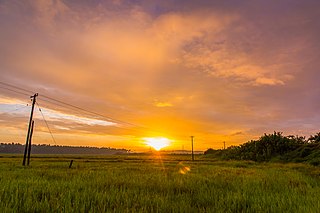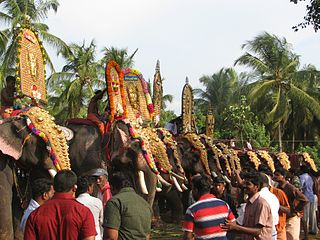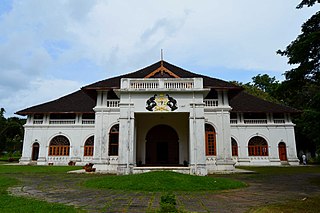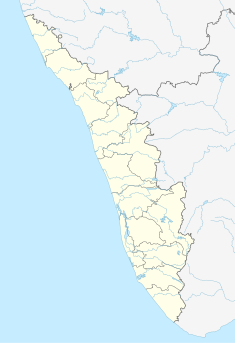
Thrissur, formerly Trichur, also known by its historical name Thrissivaperur, is a city and the headquarters of the Thrissur district in Kerala, India. It is the third largest urban agglomeration in Kerala after Kochi and Kozhikode, and the 21st largest in India. The city is built around a 65-acre (26 ha) hillock called the Thekkinkaadu Maidaanam which seats a large Hindu Shiva Temple. It is located 304 kilometres (189 mi) north-west of the state's capital city, Thiruvananthapuram. Thrissur was once the capital of the Kingdom of Cochin, and was a point of contact for the Assyrians, Greeks, Persians, Arabs, Romans, Portuguese, Dutch and English.

The ThrissurPooram is an annual Hindu temple festival held in Thrissur, Kerala, India. It is held at the Vadakkunnathan (Shiva) Temple in Thrissur every year on the Pooram day—the day when the moon rises with the Pooram star in the Malayalam Calendar month of Medam. It is the largest and most famous of all poorams in India. Thrissur pooram is also one of the largest festivals in Asia with more than 1 million visitors.

The Vadakkumnathan Temple is an ancient Hindu temple dedicated to Shiva in Thrissur, in the Thrissur district of Kerala, India. The temple is a classical example of the architectural style of Kerala and has one monumental tower on each of the four sides in addition to a koothambalam. Mural paintings depicting various scenes from the Mahabharata can be seen inside the temple. The shrines and the Kuttambalam display vignettes carved in wood. The temple, along with the mural paintings, has been declared as a National Monument by India under the AMASR Act. According to popular local lore, this is the first temple built by Parashurama, the sixth avatar of Vishnu. Thekkinkadu Maidan, encircling the Vadakkumnathan Temple, is the main venue of the renowned Thrissur Pooram festival.

Thrissur, anglicised as Trichur, is one of the 14 districts in the Indian state of Kerala. It is situated in the central region of the state. Spanning an area of about 3,032 km2 (1,171 sq mi), the district is home to over 9% of Kerala's population.

Mushika dynasty, also spelled Mushaka, was a minor dynastic power that held sway over the region in and around Mount Ezhi (Ezhimala) in present-day North Malabar, Kerala, India. The country of the Mushikas, ruled by an ancient lineage of the Hehaya clan of the same name, appears in early historic (pre-Pallava) south India and it is believed that Mushika dynasty has their descents from Heheya Kingdom. Early Tamil poems contain several references to the exploits of Nannan of Ezhimalai. Nannan was known as a great enemy of the pre-Pallava Chera chieftains. The clan also had matrimonial alliances with the Chera, Pandya and Chola chieftains. The Kolathunadu (Kannur) Kingdom, which was the descendant of Mushika dynasty, at the peak of its power, reportedly extended from Netravati River (Mangalore) in the north to Korapuzha (Kozhikode) in the south with Arabian Sea on the west and Kodagu hills on the eastern boundary, also including the isolated islands of Lakshadweep in the Arabian Sea.

Pattanam is a village located in the Ernakulam District in the southern Indian state of Kerala. It is located 2 km north of North Paravur, 6 km and East of Chendamangalam 25 km north of Kochi (Cochin).

Chermanangad is a small village on the road between Kunnamkulam and Wadakanchery in the Thrissur district of Kerala.

Shakthan Thampuran Palace is situated in City of Thrissur in Kerala state, India. It is named as Vadakkekara Palace, was reconstructed in Kerala-Dutch style in 1795 by Ramavarma Thampuran of the erstwhile Princely State of Cochin, well as Sakthan Thampuran is preserved by Archaeological Department. The palace was converted into a museum in 2005 by State.

Thrissur is the administrative capital of Thrissur District, in the central part of Kerala state, India. Thrissur district was formed on 1 July 1949. It is an important cultural centre, and is known as the Cultural Capital of Kerala. It is famous for the Thrissur Pooram festival, one of the most colourful and spectacular temple festival of Kerala. From ancient times, Thrissur has been politically, economically and culturally significant to the Indian subcontinent. It has opened the gates for Arabs, Romans, Portuguese, Dutch and English. According to tradition, Thrissur is where Christianity, Islam and Judaism entered the Indian subcontinent. Local Christian tradition holds that Thomas the Apostle arrived in 52 CE, and Muslim tradition states that Methala is the location of country's first mosque.
Pullazhi or Pullazhy, is a suburban area of Thrissur City in Kerala state, south India. It is almost 6 km away from Swaraj Round. Pullazhy is surrounded by paddy fields called "Kolpadavu", supervised and controlled by Pullazhi Kolpadavu Sahakarana Sangham. Many of the native families have an agrarian background. The village also contains a library called "Yuvajana Sangham Vayanasala".

Hill Palace is an archaeological museum and palace located in the Thrippunithura neighbourhood of Kochi, Kerala. It is the largest archeological museum in the state and was the imperial administrative office and official residence of the Cochin Maharaja. Built in 1865, the palace complex consists of 49 buildings spreading across 54 acres (220,000 m2) and built in the traditional architectural style. The complex has an archaeological museum, a heritage museum, a deer park, a pre-historic park and a children's park.

Thrissur is one of the 20 Lok Sabha (parliamentary) constituencies in the state of Kerala in southern India. It consists of seven assembly segments in Thrissur district.
Ramavarmapuram is the northern suburb of Thrissur City in Kerala. This suburban area is home to several governmental and other institutions of national importance. The largest menhir type megalithic monument in granite in Kerala is found here. A local catholic church has recently been adorned with mural paintings in the traditional Kerala style. This is the first instance of such a church decoration in Kerala in modern times.

Archaeological Museum, Thrissur is an art and archaeological museum situated in Thrissur City of Kerala state, India. The museum is located in the Thrissur Zoo compound.

Marth Mariam Cathedral is the cathedral of the Chaldean Syrian Church of India, part of the Assyrian Church of the East. It is located in Thrissur City in the state of Kerala, It is the city's first Christian church inside the fort gates and is the fourth church in the Thrissur Municipal Corporation

Thrissur-Ponnani Kole Wetlands is a wetland lying in Thrissur and Malappuram districts in Kerala, India. It gives 40 per cent of the Kerala’s rice requirement and acts as a natural drainage system for Ponnani city, Thrissur city, Thrissur District, and Malappuram district. The Kole Wetlands is one of largest, highly productive and threatened wetlands in Kerala and it comes in Central Asian Flyway of migratory birds.

Chavakkad Beach is a beach in Chavakkad Municipality of Thrissur District in the Indian state of Kerala. It lies on the Arabian Sea coast and attracts tourists. The beach is situated 5 Kilometers from Guruvayoor Temple Sri Krishna Temple. At this beach the river meets the sea forming an estuary. The meeting point is known as Azhimukham in Malayalam. It is counted amongst Kerala’s most popular beaches because it is unexplored by domestic tourists.

Kudakkallu Parambu is a prehistoric Megalith burial site located in Chermanangad of Thrissur District of Kerala. The site has 69 megalithic monuments spread over a small area. Different types of burials in this area include Topikkal, Kudakkal, multiple hood stones and stone circles. The Archaeological Survey of India says that these monuments were built around 2000 BCE. The Archaeological Survey of India has declared it as a centrally protected monument.

Chovvanur Burial Cave is a prehistoric Megalith rock cut cave situated in Chowannur, of Thrissur District of Kerala. The cave can be accessed from single entry and its chamber is circular. The cave has a single chamber and two benches. The Archaeological Survey of India has declared this cave as centrally protected monument.

Eyyal Burial Cave is a prehistoric Megalith rock cut cave situated in Eyyal, of Thrissur District of Kerala. The cave can be accessed from single entry and its chamber is circular. Archaeological Survey of India has declared this cave as centrally protected monument.


























